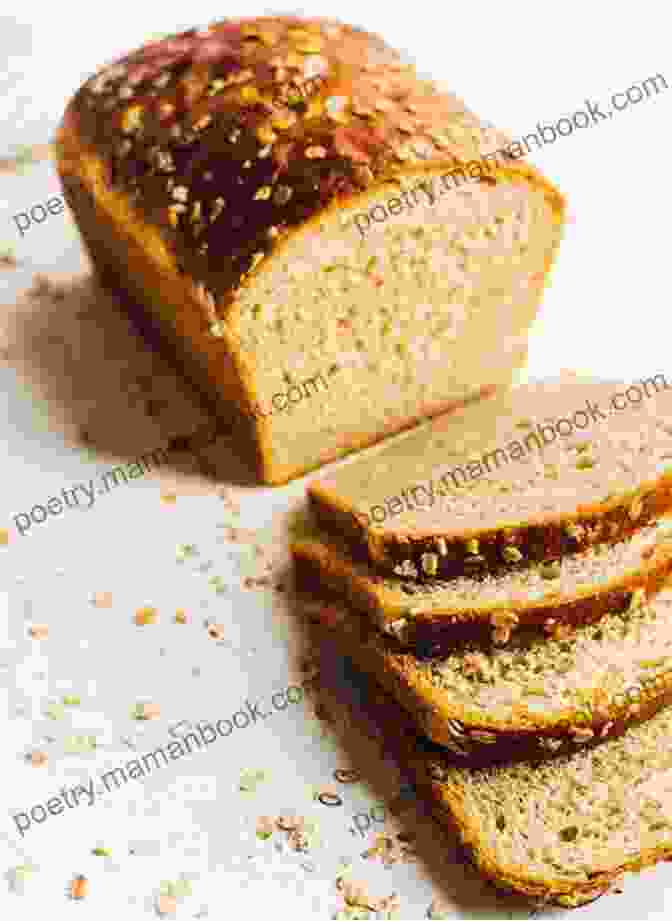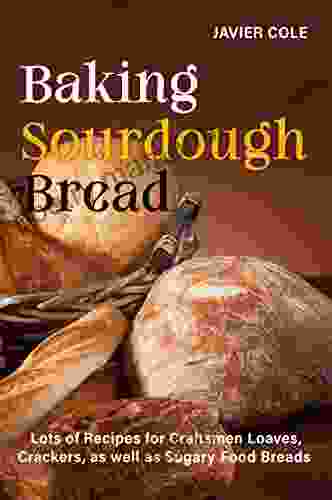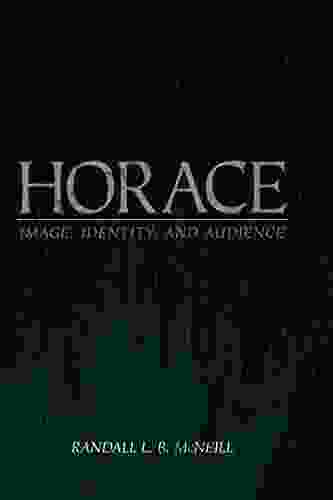Baking Sourdough Bread: A Comprehensive Guide for Artisans, from Loaves to Crackers

Sourdough bread, with its distinctive tangy flavor and chewy texture, has captured the hearts of bread enthusiasts worldwide. This ancient bread-making technique relies on the power of wild yeast and lactic acid bacteria to create a unique and flavorful loaf. For centuries, sourdough bread has been a staple food, offering both taste and nutritional benefits. In this article, we will delve into the fascinating world of sourdough bread baking, exploring the techniques, ingredients, and recipes that will enable you to craft exceptional loaves, crackers, and more.

4.2 out of 5
| Language | : | English |
| File size | : | 29389 KB |
| Text-to-Speech | : | Enabled |
| Enhanced typesetting | : | Enabled |
| Print length | : | 125 pages |
| Screen Reader | : | Supported |
Understanding the Science of Sourdough
At the heart of sourdough bread lies a natural fermentation process. Wild yeast, present in the air and on grain surfaces, is captured and cultivated in a sourdough starter. This starter is a mixture of flour and water that is regularly fed and maintained. As the yeast feeds on the sugars in the flour, it produces carbon dioxide and lactic acid, which give sourdough bread its characteristic flavor and texture.
Lactic acid bacteria, also present in the starter, contribute to the sourness of sourdough bread. These bacteria produce lactic acid, which lowers the pH of the dough, inhibiting the growth of harmful bacteria and extending the bread's shelf life. The combination of wild yeast fermentation and lactic acid bacteria creates a complex and flavorful bread that is both delicious and nutritious.
Essential Ingredients for Sourdough Baking
- Flour: High-quality bread flour or whole wheat flour provides the structure and nutrients for the dough.
- Water: Pure, filtered water is essential for hydration and activating the yeast.
- Sourdough Starter: This living culture of yeast and lactic acid bacteria is the catalyst for the sourdough bread fermentation process.
- Salt: Salt enhances the flavor and strengthens the gluten network in the dough.
Step-by-Step Guide to Baking Sourdough Bread
- Create or Refresh Your Sourdough Starter: Feed your sourdough starter with equal parts flour and water, allowing it to ferment for several hours or overnight.
- Autolyse the Dough: Combine flour and water in a large bowl and mix until just combined. Cover the bowl and let the dough rest for 30-60 minutes, which allows the flour to absorb the water and develop gluten.
- Add the Sourdough Starter and Salt: Break up the sourdough starter and add it to the dough along with the salt. Mix until the ingredients are well combined.
- Knead or Stretch and Fold the Dough: This step develops the gluten network, giving the bread its structure and elasticity. You can knead the dough by hand or use a stand mixer. Alternatively, you can perform stretch and fold techniques, gently stretching and folding the dough several times at regular intervals.
- Bulk Fermentation: Place the dough in an oiled bowl, cover it, and let it ferment at room temperature for several hours, or even overnight. The dough will rise and become more flavorful as the yeast and bacteria produce carbon dioxide and lactic acid.
- Shaping: Once the dough has fermented, shape it into your desired loaf or shape. You can make classic round loaves, batards (oblong loaves),or baguettes.
- Final Proofing: Place the shaped dough on a floured baking sheet or in a proofing basket, cover it, and let it proof at room temperature for 1-2 hours, or until the dough has doubled in size.
- Scoring: Before baking, score the top of the dough with a sharp knife or razor blade. This will allow the bread to expand during baking and create a beautiful crust.
- Baking: Preheat your oven to a high temperature (450-500°F) and bake the bread for 30-45 minutes, or until the crust is golden brown and the bread sounds hollow when tapped.
- Cooling: Let the bread cool completely on a wire rack before slicing and serving.
Additional Tips for Baking Sourdough Bread
- Use a Thermometer: Monitoring the dough temperature is crucial to ensure optimal fermentation. Aim for a dough temperature of around 75-85°F during bulk fermentation.
- Practice Patience: Sourdough bread takes time to ferment and develop its full flavor. Be patient and allow for adequate rising and fermentation times.
- Control the Sourness: The sourness of sourdough bread can vary depending on the fermentation time and the type of flour used. For a milder sourness, ferment the dough for a shorter period or use less whole wheat flour.
- Experiment with Different Flours: While bread flour or whole wheat flour are traditional choices, you can experiment with other flours such as rye flour, spelt flour, or even gluten-free flours.
- Create a Sourdough Culture: If you don't have access to a sourdough starter, you can create your own by combining equal parts flour and water in a jar and feeding it regularly for several days.
Recipes for Sourdough Bread, Crackers, and More
Sourdough Bread Recipes
- Classic Sourdough Loaf: This timeless recipe produces a beautiful golden-brown loaf with a chewy interior and a mild sour flavor.
- Whole Wheat Sourdough Bread: For a more nutritious and earthy loaf, use whole wheat flour in place of white bread flour.
- Rye Sourdough Bread: Rye flour imparts a distinctive nutty flavor and a darker color to the bread, making it a perfect choice for hearty sandwiches.
- Baguettes: Create these delicate French loaves with a crispy crust and a soft interior.
- Sourdough Pizza Crust: Use sourdough as the base for your homemade pizzas, resulting in a flavorful and crispy crust.
Sourdough Cracker Recipes
- Sourdough Crackers: These crispy and flavorful crackers are a perfect snack or accompaniment to soups and salads.
- Rosemary and Sea Salt Sourdough Crackers: Enhance the flavor of sourdough crackers with the addition of aromatic rosemary and flaky sea salt.
- Whole Wheat Sourdough Crackers: For a more robust flavor and texture, use whole wheat flour to create these hearty crackers.
Sourdough Other Recipes
- Sourdough Pancakes: Start your day with fluffy and tangy sourdough pancakes.
- Sourdough Waffles: Enjoy crispy and flavorful sourdough waffles topped with your favorite fruits or syrup.
- Sourdough Cinnamon Rolls: Indulge in sweet and aromatic sourdough cinnamon rolls, perfect for a weekend treat.
- Sourdough Pretzels: Create chewy and addictive sourdough pretzels, a great snack or appetizer.
Baking sourdough bread is a rewarding and enjoyable experience that allows you to create delicious and nutritious homemade bread. Whether you are a seasoned baker or a beginner, the techniques and recipes outlined in this article will empower you to craft exceptional sourdough loaves, crackers, and more. Embrace the art of sourdough baking and savor the unique flavor and texture that only this ancient bread-making tradition can provide.
4.2 out of 5
| Language | : | English |
| File size | : | 29389 KB |
| Text-to-Speech | : | Enabled |
| Enhanced typesetting | : | Enabled |
| Print length | : | 125 pages |
| Screen Reader | : | Supported |
Do you want to contribute by writing guest posts on this blog?
Please contact us and send us a resume of previous articles that you have written.
 Top Book
Top Book Novel
Novel Fiction
Fiction Nonfiction
Nonfiction Literature
Literature Paperback
Paperback Hardcover
Hardcover E-book
E-book Audiobook
Audiobook Bestseller
Bestseller Classic
Classic Mystery
Mystery Thriller
Thriller Romance
Romance Fantasy
Fantasy Science Fiction
Science Fiction Biography
Biography Memoir
Memoir Autobiography
Autobiography Poetry
Poetry Drama
Drama Historical Fiction
Historical Fiction Self-help
Self-help Young Adult
Young Adult Childrens Books
Childrens Books Graphic Novel
Graphic Novel Anthology
Anthology Series
Series Encyclopedia
Encyclopedia Reference
Reference Guidebook
Guidebook Textbook
Textbook Workbook
Workbook Journal
Journal Diary
Diary Manuscript
Manuscript Folio
Folio Pulp Fiction
Pulp Fiction Short Stories
Short Stories Fairy Tales
Fairy Tales Fables
Fables Mythology
Mythology Philosophy
Philosophy Religion
Religion Spirituality
Spirituality Essays
Essays Critique
Critique Commentary
Commentary Glossary
Glossary Bibliography
Bibliography Index
Index Table of Contents
Table of Contents Preface
Preface Introduction
Introduction Foreword
Foreword Afterword
Afterword Appendices
Appendices Annotations
Annotations Footnotes
Footnotes Epilogue
Epilogue Prologue
Prologue Anatole Lyovin
Anatole Lyovin Bradley J Wojcik
Bradley J Wojcik Graham Ison
Graham Ison Catherine Cho
Catherine Cho Naomi Kelly
Naomi Kelly Daniel Schinhofen
Daniel Schinhofen Georgina Herrera
Georgina Herrera Andrew Greig
Andrew Greig Diamond Layne
Diamond Layne Mark Allen Atterson
Mark Allen Atterson Ava Benton
Ava Benton Kindle Comixology
Kindle Comixology Gopal Parajuli
Gopal Parajuli David M Booher
David M Booher Gilda Sask
Gilda Sask Wagner Kerchaten
Wagner Kerchaten Emma Savant
Emma Savant Princess Marie Chantal Of Greece
Princess Marie Chantal Of Greece Project Learning Tree
Project Learning Tree 1st Edition Kindle Edition
1st Edition Kindle Edition
Light bulbAdvertise smarter! Our strategic ad space ensures maximum exposure. Reserve your spot today!
 Easton PowellFollow ·7.9k
Easton PowellFollow ·7.9k Robert ReedFollow ·3.5k
Robert ReedFollow ·3.5k Isaac AsimovFollow ·11.6k
Isaac AsimovFollow ·11.6k Curtis StewartFollow ·6.1k
Curtis StewartFollow ·6.1k Fernando BellFollow ·4.3k
Fernando BellFollow ·4.3k Victor TurnerFollow ·3k
Victor TurnerFollow ·3k Arthur C. ClarkeFollow ·17k
Arthur C. ClarkeFollow ·17k Jimmy ButlerFollow ·9.8k
Jimmy ButlerFollow ·9.8k

 Patrick Hayes
Patrick HayesDeath on Stage: Euphemia Martins Mystery 16
Synopsis In the...

 Benji Powell
Benji Powell1001 Best Baking Recipes Of All Time
Baking is a fun and...

 Terry Bell
Terry BellDestined War of the Covens: A Supernatural Saga of Power,...
Welcome to the...

 Mark Twain
Mark TwainBitcoin For Mere Mortals: A Comprehensive Guide for...
Bitcoin is a...

 Dennis Hayes
Dennis HayesThe Best Budget Gaming PC 2024: Build the Ultimate Gaming...
Are you looking to build the best budget...
4.2 out of 5
| Language | : | English |
| File size | : | 29389 KB |
| Text-to-Speech | : | Enabled |
| Enhanced typesetting | : | Enabled |
| Print length | : | 125 pages |
| Screen Reader | : | Supported |














